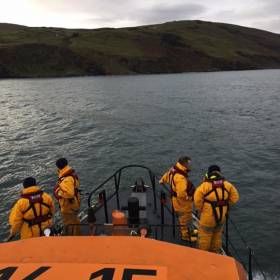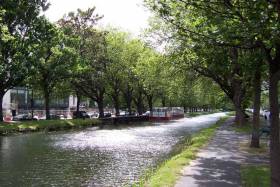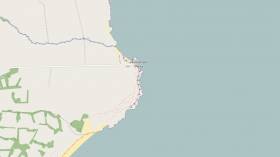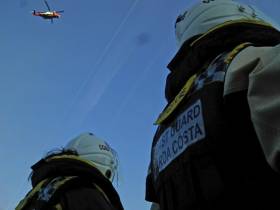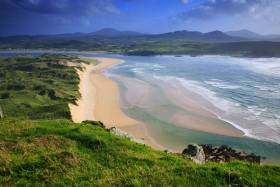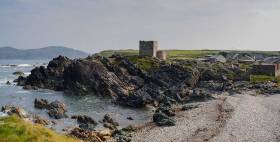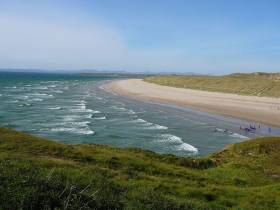Displaying items by tag: missing
Search For Missing Man In Wicklow Harbour
#Missing - RTÉ News reports on the ongoing search for a man in his 50s reported missing in Wicklow Harbour this morning (Tuesday 27 December).
Wicklow RNLI, the Irish Coast Guard and gardaí are all involved in the operation that began around 10.30am.
The news comes two just days after a man was rescued from the River Liffey in Dublin city centre on Christmas morning, as previously reported on Afloat.ie.
Red Bay Lifeboat Joins Search For Missing Person
#RNLI - Volunteers from Red Bay RNLI in Co Antrim joined in the ongoing search for a missing woman yesterday (Sunday 18 December).
The all-weather lifeboat, under coxswain Paddy McLaughlin and with six crew members onboard, launched at 11.30am and continued searching until 6pm yeserday evening.
The lifeboat started its search in the area of Ballintoy before moving south to Torr Head. Coastguard units meanwhile searched the shoreline.
Weather conditions were favourable with a cold but moderate sea and good visibility.
“We searched in good conditions for most of today but unfortunately we didn’t find anything,” said McLaughlin.
“Our thoughts remain with the lady’s family during an ongoing search.”
Elsewhere, the volunteer lifeboat crew at Larne RNLI responded to a launch request from the UK Coastguard yesterday morning.
The initial alarm was raised by a concerned member of the public who reported seeing a person signalling to shore from a fishing vessel around 1.5 nautical miles off Glenarm.
Larne RNLI’s all-weather lifeboat launched at 10.45am and quickly made its way to Glenarm. The lifeboat crew made radio contact with a fishing vessel in the area who confirmed they did not require any assistance.
The surrounding area was searched to ensure there were no other vessels nearby. The lifeboat was returned to Larne after it was established as a false alarm with good intent.
Speaking following the callout, Larne RNLI coxswain Frank Healy said: “We thank this vigilant member of the public who called the coastguard out of genuine concern.
“We would urge anyone who is concerned that someone is in distress along our coast to always ring 999 and ask for the coastguard. We would always rather launch to a false alarm with good intent than not launch at all.”
Larne RNLI will host its annual icebreaker swim at 12 noon on New Year’s Eve at Ballygally Beach.
The lifeboat station is asking people to 'Get freezin' for a reason' this New Year’s Eve, with all money raised going to the RNLI to help save lives at sea.
Anyone interested in taking part can obtain a sponsor form by contacting 07516 496945 or the station’s Facebook page, or collect on the day.
Hot refreshments will be available at the Ballygally community centre following the swim.
Body Recovered From Grand Canal In Search For Missing Man
#GrandCanal - BreakingNews.ie reports on the recovery of a body from the Grand Canal in Dublin yesterday (Sunday 18 December) in the search for a missing man.
The body was recovered by the Garda Water Unit at lunchtime yesterday near Harcourt Terrace in the city centre during the search for 25-year-old Mehdi Hasan, who was last seen in on Leeson Street around 4am on Friday morning (16 December).
Body Recovered In Search For Woman Missing From Irish Sea Ferry
#Ferry - The body of a woman was recovered from the water in South Wales yesterday (Friday 2 December) after a major search operation for a person missing from a Pembroke-to-Rosslare ferry, as the Western Telegraph reports.
Irish Ferries’ Isle of Inishmore contacted the UK Coastguard from Rosslare shortly after 8am when the passenger was noted as missing and feared to have gone overboard, according to Sky News, prompting a major air and sea search of the Irish Sea and the Pembroke Channel at Milford Haven.
Dyfed Powys Police later confirmed the discovery of a body in the Lawrenny area east of Pembroke Dock in the upper reaches of the Western Cleddau, though it has not formally been identified.
Search Resumes For Missing Fisherman Off Wicklow-Wexford Border
#Missing - The search was set to resume this morning for a fisherman missing after going overboard from a three-man fishing vessel off the Wicklow-Wexford border yesterday morning (Wednesday 16 November).
As The Irish Times reports, RNLI lifeboats from Rosslare and Wicklow were tasked along with the Waterford-based Irish Coast Guard helicopter Rescue 117 and later Rescue 116 from Dublin Airport to the incident some 6km east of Kilmichael Point in Co Wexford.
It's understood that the missing man is in his late 40s or eary 50s, according to BreakingNews.ie.
Body Recovered In Search For Missing Teacher Off Kilkee
#Kilkee - BreakingNews.ie reports that a body was recovered yesterday (Saturday 24 September) off Kilkee in the search for missing teacher David McMahon.
Hundreds had been involved in the search for the school teacher, who was last seen on 9 September, according to Independent.ie.
The discovery yesterday afternoon came 12 days after the death of Irish Coast Guard volunteer Caitriona Lucas in the same area.
That tragedy occurred when the RIB she and two other coastguard volunteers were on board was flipped over in a heavy swell, three days into the search operation for McMahon off the Co Clare coast.
Coastguard Member Dies During Search Off Kilkee
#Coastguard - RTÉ News is reporting that a member of the Irish Coast Guard has died after a rescue boat overturned during a search for a man missing of Kilkee this afternoon (Monday 12 September).
Two other coastguard crew were recovered from the water and taken to hospital after the RIB all three were onboard flipped over in a heavy swell.
More on this story as it develops.
Body Found In Search For Missing Holidaymaker Off Inishowen
#IsleOfDoagh - A body has been found this afternoon (Thursday 1 September) in the search for a man missing from the Isle of Doagh since Monday evening.
As previously reported on Afloat.ie, the man was reported missing by his family after going swimming during a camping holiday on the Inishowen Peninsula.
But according to The Irish Times, a body was recovered at Five Fingers Strand across from Doagh in the search for 59-year-old Tony Griffiths.
Search Resumes For Missing Holidaymaker Off North Donegal
#Missing - The search continues today (Wednesday 31 August) for a man missing after going swimming off the Inishowen Peninsula in Co Donegal this past Monday.
According to The Irish Times, the man in his 50s was reported missing at midnight on Monday by his family, with whom he was on a camping holiday on the Isle of Doagh just south of Malin Head.
The search comes just days since the body of soldier Gavin Carey was recovered off the south Donegal coast near Bundoran after he got into difficulty while swimming a week ago.
Body Of Missing Soldier Recovered Off Donegal Coast
#Donegal - A body recovered off the Donegal coast yesterday morning (Sunday 28 August) has been identified as missing soldier Gavin Carey, according to BreakingNews.ie.
Corporal Gavin Carey was reported missing after getting into difficulty while swimming with fellow soldiers at Tullan Strand last Tuesday 23 August, as previously reported on Afloat.ie.
Defence Forces chief of staff Vice Admiral Mark Mellett expressed his sorrow over the tragedy, with Taoiseach Enda Kenny also offering his condolences to Corporal Carey's family in Mullingar and colleagues at Custume Barracks in Athlone.
BreakingNews.ie has much more on the story HERE.



























